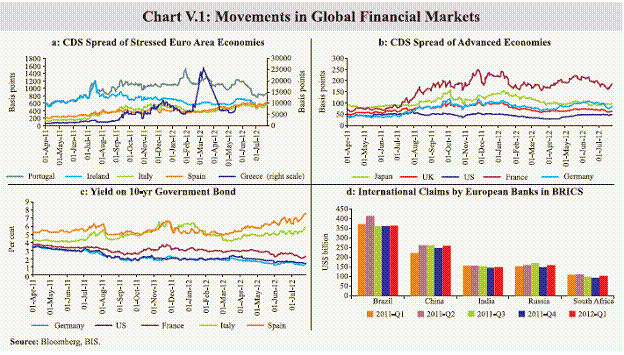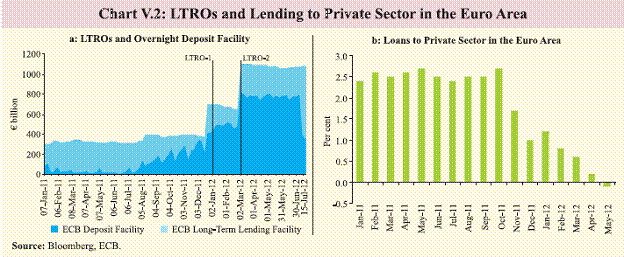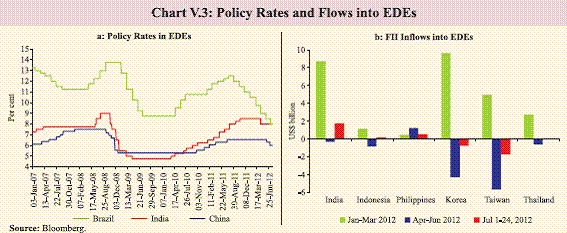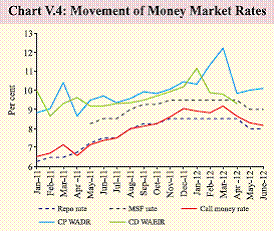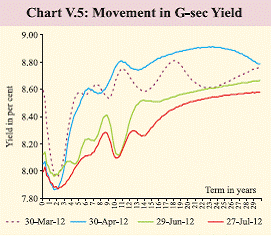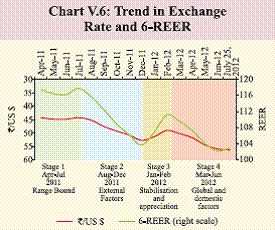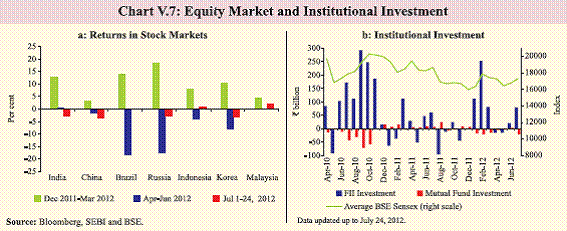 IST,
IST,
V. Financial Markets
Global financial conditions deteriorated further during Q1 of 2012-13 as Greece and Spain came near flashpoint, requiring further bailouts to contain the contagion. The LIBOR-fixing case further demonstrated the fragilities in the banking and financial market space. Subdued global growth is increasing spillover risks, even as fresh rounds of austerity measures have been put in place to tackle the sovereign debt crisis. The financial markets in India also remained under pressure with increased volatility in the currency and equity markets, in line with the other emerging economies. The Reserve Bank undertook a slew of measures to boost capital flows and also to ensure adequate liquidity in the domestic money markets. Optimism for euro area recovery fades as uncertainties re-emerge V.1 Euro area difficulties increased sharply in Q1 of 2012-13, first as political parties in Greece failed to form a new government necessitating re-elections, and later with the deepening banking crisis in Spain. Prior to the re-elections in Greece, markets viewed Greece’s exit from the euro area as imminent. Even after the pro-euro coalition of parties came to power in the Greece re-elections, market uncertainty prevails on how long Greece may stay as part of the euro area. A heightened Spanish banking problem has increased the risks to euro area financial stability. The risks associated with sovereign debt indicated by spreads of credit default swaps (CDS) has, in general, increased over end-March 2012 levels (Chart V.1 a, b). V.2 The subdued economic outlook and increased risk aversion drove investors to safe assets such as US and German sovereign bonds leading to lower yields. On the other hand, the G-sec yields of countries perceived as riskier rose significantly (Chart V.1 c). V.3 Increased funding pressures and regulatory requirements, compounded by the uncertainties in the euro area, have intensified deleveraging by European banks since H2 of 2011-12. The impact of deleveraging was also evident as international claims by European banks in BRICS countries declined in the second half of 2011 (Chart V.1d). Going forward, the pace of deleveraging may slow down. However, the ongoing regulatory reforms and proposed implementation of Basel III recommendations in 2013 may lead to continued tightening of lending conditions.
V.4 Since Q3 of 2011-12, the euro area economy has either contracted or remained stagnant. The difficulties in the euro area have triggered an austerity versus growth debate, reflecting the perception that austerity-focused policies have contributed to economic hardship while failing to eliminate the existential threat to the euro. Despite the two Long-Term Refinancing Operations (LTROs) conducted by the ECB that infused more than €1 trillion into the system, credit off-take has remained subdued. Much of the liquidity found its way back to the ECB’s overnight deposit facility, while the growth in private sector lending turned negative in May 2012 (Chart V.2). Policy Response to Slowing Growth and Sovereign Debt Concerns V.5 Significant headwinds from the euro area have compounded the global slowdown, prompting widespread growth-enabling policy measures towards the end of Q1 of 2012-13. Recent initiatives by the European Council to alleviate economic and financial pressures in the euro area include proposals to establish a single supervisory mechanism involving the ECB, the European Stability Mechanism (ESM) and plausible direct recapitalisation of banks. However, a robust long term solution is pending. This is highlighted by the return of stress in the financial markets following Moody’s decision to attach a negative outlook on the Aaa sovereign rating of Germany, Netherlands and Luxembourg and the debt rollover difficulties being faced by Spain and Italy. Thereafter, the Spanish yields firmed up. involving the ECB, the European Stability Mechanism (ESM) and plausible direct recapitalisation of banks. However, a robust long term solution is pending. This is highlighted by the return of stress in the financial markets following Moody’s decision to attach a negative outlook on the Aaa sovereign rating of Germany, Netherlands and Luxembourg and the debt rollover difficulties being faced by Spain and Italy. Thereafter, the Spanish yields firmed up. Capital inflows into emerging markets decline as growth moderates V.6 Subdued growth in the advanced economies (AEs) and euro area concerns coupled with moderation in domestic growth conditioned the financial markets of emerging and developing economies (EDEs), with FII inflows turning negative for most EDEs (Chart V.3). However, following the slew of monetary easing measures in most AEs towards the end of Q1 and early Q2 of 2012-13, the trend is expected to reverse moderately. Declining equity market trends as well as the depreciation of EDE currencies against the US dollar underscore the damp investor sentiments. Indian financial markets impacted by lower growth, decline in capital inflows and euro area uncertainty V.7 Lower growth, persistent inflation and concerns over fiscal and current account deficits, in addition to the global economic weakness and the re-emergence of the euro area crisis, conditioned the Indian financial markets in Q1 of 2012-13. Money market rates declined during 2012-13 so far, reflecting improved liquidity conditions in the system and the 50 bps reduction in the repo rate announced in the Monetary Policy Statement 2012-13. The G-sec yields declined reflecting the lower growth expectations, global risk aversion driven flight to safe-haven government securities and purchase of securities through OMO. Funding strains kept deposit rates sticky, nevertheless, the base rate of banks showed a slight moderation. In line with other Asian countries, the Indian rupee depreciated, but by a higher magnitude on account of exacerbated concerns on current account and fiscal deficits. Equity markets declined led by a weak investment climate, muted domestic growth and FII outflows in Q1 of 2012-13.
Call rate eased reflecting improved liquidity conditions V.8 With liquidity conditions remaining significantly tight in March 2012 on account of quarterly advance tax outflows and rise in currency in circulation, all segments of the money market witnessed an increase in rates. However, during Q1 of 2012-13, the liquidity conditions eased with the average daily LAF injection showing a declining trend (Table V.1). Supported by the cut in policy rate and improved liquidity conditions (partly due to the OMOs by the Reserve Bank), the call rate declined subsequently (Chart V.4). V.9 The rates in the collateralised segments moved in tandem with the call rate, but have generally remained below it during 2012-13 so far. Banks and primary dealers remain the major groups of borrowers in the collateralised segments, while mutual funds (MFs) continue as the major group of lenders.
V.10 CD rates spiked during March 2012, reflecting overall tight liquidity conditions in the money markets and the reluctance of MFs to rollover bank CDs after asset management companies were made accountable for fair valuations on a mark-to-market basis. CP rates firmed up similarly. However, since then the weighted average effective interest rates (WAEIR) on CDs and the weighted average discount rate (WADR) of commercial paper (CP) declined, following improved liquidity conditions. G-sec yields declined, reflecting the domestic economic situation, declining crude oil prices V.11 Driven by expectations of a rate cut in the Annual Policy of the Reserve Bank, and also by concerns of weakening industrial and export growth, G-sec yields softened at the beginning of Q1 of 2012-13. However, S&P’s revision of India’s long term rating outlook to negative led yields to temporarily firm up towards the end of April 2012. The declining trend in crude oil prices, general risk aversion and purchase of securities through OMO caused the yields to ease thereafter (Chart V.5). V.12 Yields continued to soften during the first half of June 2012 following the disappointing growth figure for Q4 of 2011-12 at 5.30 per cent. On the whole, in Q2 of 2012-13 so far, the yields exhibited a softening bias. According to SEBI data, FIIs made investments in debt worth `51.5 billion in 2012-13 so far (up to July 23, 2012). MFs also bought debt worth `1,535.5 billion during the same period.
V.13 The markets remain cautious about the reduction in fiscal deficit. Gross market borrowings of the government through dated securities during 2012-13 were `2.3 trillion (net borrowings `1.6 trillion) up to July 23, 2012 compared with `1.6 trillion (net borrowings `1.1 trillion) during the corresponding period of the previous year (Table V.2). During 2012- 13 (up to July 23, 2012), 20 states raised `420 billion on a gross basis (net `370 billion) compared with `370 billion on a gross basis (net `303 billion) raised by 14 states during the corresponding period of 2011-12. The weighted average yield firmed up to 9.0 per cent up to July 23, 2012 from 8.6 per cent for the same period in the previous year.
Deposit rates of banks stay sticky, reflecting higher costs and inflation V.14 The modal deposit rates for scheduled commercial banks (SCBs) declined marginally by 2 bps to 7.40 per cent across all maturities during Q1 of 2012-13, while the modal base rate of SCBs declined by 25 bps to 10.50 per cent (Table V.3). Banks’ response on deposit rates remain rather muted so far, reflecting the interplay of factors such as tight liquidity conditions in Q1 of 2012-13 and high inflation. Rupee depreciated sharply amid concerns of widening current account and fiscal deficit and global uncertainty V.15 In Q4 of 2011-12, the Indian rupee reversed its falling streak exhibited during most of the year and recorded some gains. Owing to the interplay of a mix of domestic and global factors (see para III.6 page 19), the rupee started weakening from April 2012. Subsequently however, the rupee gained due to improved FII flows coupled with the lower trade deficit partly aided by policy initiatives. The distinct phases and primary drivers of the rupee movement over the course of the year have been mapped in Chart V.6. V.16 The depreciation of the exchange rate in Q1 of 2012-13 is not specific to India; most EDE currencies have also depreciated. However, the depreciation of Indian rupee is large reflecting growing current account deficit unlike other major Asian economies who have current account surpluses (Table V.4). Equity markets turned cautious on concerns about the investment climate V.17 The slow recovery in Q4 of 2011-12 reversed for most part of Q1 of 2012-13, on the backdrop of deceleration in IIP growth, weak revenue outlook for major Indian IT companies and concerns over the implementation of retrospective tax and general anti-avoidance rules (GAAR). Euro area crisis, the downgrade of India’s long term rating outlook to negative from stable and the rupee slide also affected the market sentiment. However, the later part of June 2012 saw the market turnaround from low levels on account of a pick-up in FII investment in the equity market, clarifications by the government on retrospective tax, GAAR and the government decision to boost investments in infrastructure, and, on the global front, the European Council’s decision to support stressed euro area sovereigns and banks. SEBI data indicate that FIIs sold shares worth `9.8 billion in Q1 of 2012-13, while MFs sold shares worth `6.4 billion during the same period (Chart V.7). V.18 In Q2 of 2012-13 so far (up to July 23, 2012), the equity market recovered aided by FII investments (`78.7 billion), moderation in the depreciation of the rupee and the easy monetary policy pursued globally.
The primary market remained subdued V.19 The low risk appetite of investors coupled with a weak secondary market and negative returns on IPOs led to low resource mobilisation in the primary segment in 2011-12. During 2012-13 so far (up to end-June 2012), the primary market continued to remain muted, with only `5 billion mobilised through six public issues (four IPO and two rights issues) (Table V.5).
Housing prices increased in most cities despite lower volumes V.20 According to the Reserve Bank’s quarterly House Price Index (HPI) during Q4 of 2011-12 housing prices in all cities, except Kolkata, showed an increase on a y-o-y basis. Compared to the previous quarter, housing prices show a moderation for Bengaluru, Lucknow and Chennai (Table V.6). The number of housing transactions on an annual basis shows mixed trends, with the average all-India Index remaining almost unchanged. While Mumbai, Delhi, Ahmedabad and Bengaluru report a decline in transaction volumes on an annual basis, the quarterly decline in five out of nine cities has led to a decline in the all-India transaction volume index growth. Despite transaction volumes moderating in the later part of 2011-12, housing prices seem to have firmed up. Stressed financial conditions likely to persist V.21 Financial conditions are likely to remain uncertain in the near-term with the stress likely to persist for some time, given both global and domestic conditions. The recent LIBOR fixing controversy has also added to the uncertainty by drawing attention to how a few large global financial institutions allegedly manipulated one of the most commonly used market rates. The episode has also reduced market confidence in key benchmark rates. Cases of inattention to money laundering have also dented market confidence. These events add to the already existing pressures arising from euro area fragilities. V.22 On the domestic front, falling corporate earnings at a time when corporate positions are already leveraged, could keep equity markets under pressure. As such, there is a need to improve the investment climate to drive the economy out of its slowdown and improve market sentiments. While currency pressures have currently abated, uncertainty remains ahead with global risk aversion being high and the external sector weakening. |
||||||||||||||||||||||||||||||||||||||||||||||||||||||||||||||||||||||||||||||||||||||||||||||||||||||||||||||||||||||||||||||||||||||||||||||||||||||||||||||||||||||||||||||||||||||||||||||||||||
পেজের শেষ আপডেট করা তারিখ:






